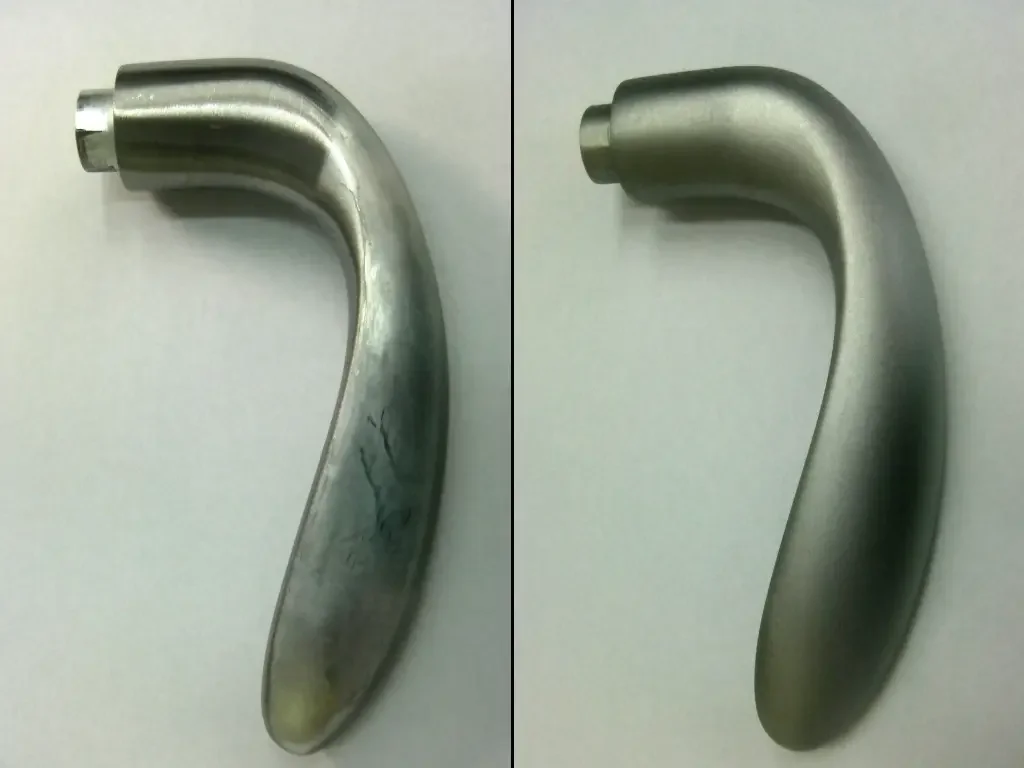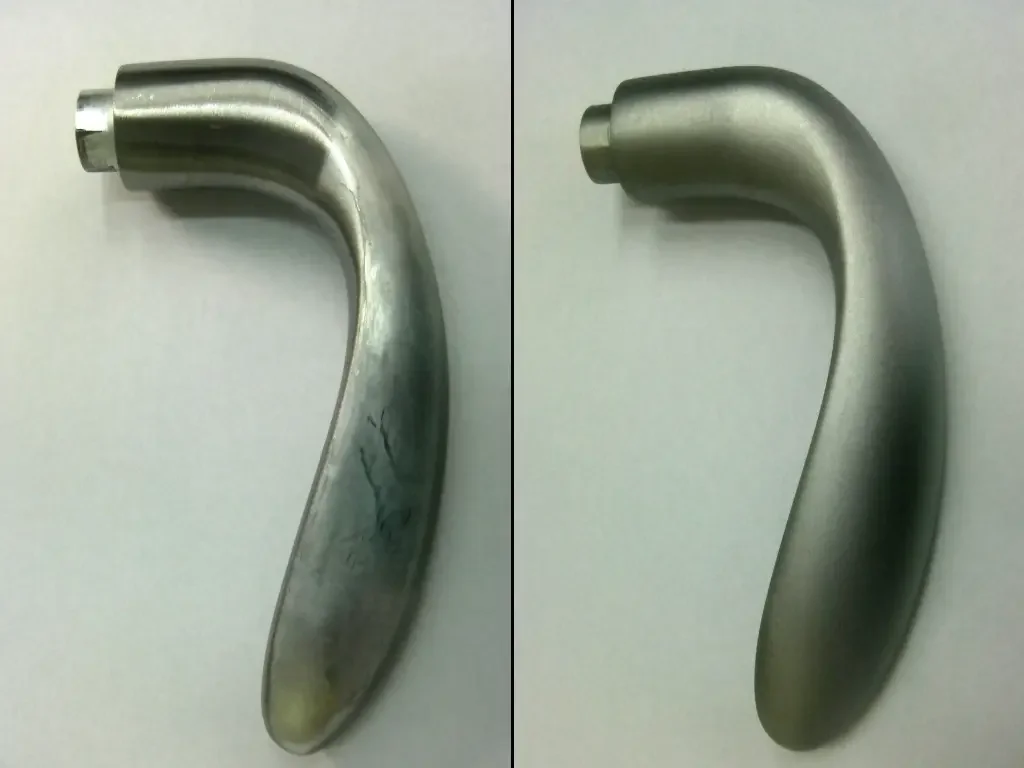Surface treatment
Last updated: 15 Sep 2025 | 7690 Views |

Outline of surface treatment

The image above is a surface-treated (shot blast) image of the doorknob. As a finishing touch after molding the material, a rough polishing process called " Satin process " is applied to give it a rough surface like that of a pear. This treatment simultaneously improves dirt (fingerprints, oil) prevention, slip resistance, texture, appearance, etc., resulting in a product with a higher-quality finish.
In this way, surface treatment is a general term for treatments for the purpose of processing and adding functions to the product surface.
・Grinding (grinding, polishing, pretreatment for painting, etching, etc.)
→Processing to shave the surface.
・Modify (hardening treatment, heat treatment, chemical conversion treatment, etc.)
→ A treatment that gives functionality directly to the surface.
・Film formation (plating, painting, alumite, thermal spraying, etc.)
→ A process in which a substance other than the base material is attached to the surface to form a film.
-------------------------------------------
Why is there such a wide range of treatment methods for treating only the surface of products? The reason for this is the importance and difficulty of "touching the outside world," where the surface of the product comes into contact with air/liquids/solids, other parts/materials, and the hands and eyes of people (purchasers). It's from It protects the interior from a wide range of external disturbances (force, rust, dirt, electricity, etc.), gives it a precise shape and necessary functionality to be combined with other parts, and expresses a design/texture that people can feel attractive. , is an important role played by surface treatment technology. Surface treatment technology is at the forefront of the interaction between things and people, from smartphones, computers, watches, chairs, tables, cars, trains, airplanes, roofs, walls, and floors of various products that we touch every day. It is also the most familiar technology in action.
------------------------------------
Scrape
The surface treatment that is thought to have been used for the longest time is processing such as grinding and polishing. Sanding is common for manual work, but industrial examples include shot blasting, in which granular abrasives are widely projected and polished, and etching, which uses the corrosive action of chemicals to degrade and dissolve the surface. processing method.
- shot blast process
This is a method of polishing by projecting granular abrasives with an impeller or air and making them collide with the material surface. A method called sandblasting, in which sand is blown, has been used for a long time, and it has evolved into various blasting machines and abrasives. A wide range of processing is possible, from rough shaving "pear finish", to "deburring" removing only unnecessary parts, to "mirror finishing" polishing the surface.
- Barrel process
This is a method of polishing the surface of materials by putting materials, abrasives (media), and water in a barrel-shaped basket (barrel) and rotating and agitating them like a washing machine.
- Etching
A process in which the material is immersed in a corrosive liquid to dissolve and remove unnecessary parts. An anti-corrosion treatment called masking can be used to protect areas that are not to be removed, while pinpointing processing is also possible.
-------------------------------------------------
modify
Improving the physical properties (such as hardness) of the product surface is also a major role of surface treatment.
- shot peening
A type of shot blasting that aims to improve the hardness and durability of the product surface. By using a spherical abrasive and hammering the surface of the product for hardening, it is a process that aims to improve durability by work hardening and imparting residual stress.
- Heating
"Quenching", which heats the surface in an atmosphere such as carbon dioxide, is a widely used treatment for surface hardening of ferrous materials. When the carbon component of the atmosphere is taken into the surface (carburizing) and heat is applied, the structure changes and the surface hardens, but the interior remains flexible, so the steel is hard to wear, supple and hard to break. Heat treatment in a nitrogen-based atmosphere such as ammonia is called nitriding.
-------------------------------------------------
Form a film
Among the surface treatments, there are a wide variety of treatments that generate a thin film on the product surface. Various purposes for processing.
・Protection (corrosion resistance, wear resistance)
・Design and decoration
・Dimension change (thickness increase)
・Adding functionality (lubricating properties, electrical properties)
etc. Typical depositions are as follows.
- Painting
The most familiar and simple film formation method is painting, which is the application of paint directly to the surface of the product. You can design and decorate your products with colored paints while protecting them from rust. Application methods include brush, roller, spray, and electrodeposition coating, in which the paint is immersed in a solution containing paint and electricity is applied to deposit the paint.
- Plating
This is a film-forming process that deposits and forms a metal film on the surface of the product, and it is possible to create a metal film that is stronger and less likely to peel off than paint. Typical examples include galvanized iron (zinc is plated on the iron surface) and tinplate (tin is plated on the iron surface). A common method is to immerse a metal material in a solution containing metal ions and apply electricity to cause an oxidation-reduction reaction, depositing the metal in the solution on the surface of the metal material on the cathode side to form a film. Non-conductors such as plastics can be plated by applying conductive treatment.
- Anodized aluminum
A typical example of a film-forming process performed on aluminum products, which is widely used for the surface treatment of kettles and pans. Anodizing is an anodizing process in which aluminum products (anode) and lead or carbon (cathode) are immersed in an electrolytic solution such as sulfuric acid and applied to oxidize the surface of the aluminum products to produce alumite. The process is similar to plating, but the difference is that the product surface layer is directly formed into a film instead of depositing a new film on the upper layer of the product surface. By anodizing, it acquires corrosion resistance, wears resistance, and electrical insulation.
- Thermal spray
In this method, a thermal spray material that has been heated and melted is sprayed onto the product and solidified on the surface to form a film. Unlike plating and anodizing, it has a wide selection of products that can be treated, and its major feature is that it can be used for alloys, ceramics, plastics, and wood products. Thermal spraying materials can also be selected from a wide range of materials such as metals, ceramics, and plastics, and various types of films can be produced. On the other hand, since the adhesive strength of the film is weak, there is a countermeasure to improve the adhesive strength by roughening the surface by shot blasting beforehand.
Related content
Blasting machine type
2 Aug 2022
What is deburring/chamfering?
15 Nov 2022
SHOTBLASTING VS AIR BLASTING
29 Jul 2022
Surface blasting
19 May 2023



